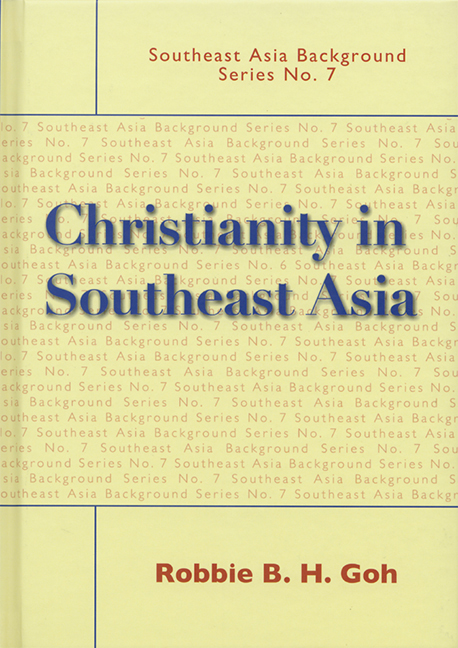Book contents
- Frontmatter
- Contents
- About the Author
- 1 Introduction: Missionary Movements and the Coming of Christianity to Southeast Asia
- 2 The Philippines
- 3 Singapore
- 4 Malaysia
- 5 Indonesia
- 6 Christianity in the Other Countries of Southeast Asia: Brunei, Myanmar, Thailand, Cambodia, Laos and Vietnam
- 7 Christianity in the Other Countries of Southeast Asia: Brunei, Myanmar, Thailand, Cambodia, Laos and Vietnam
- References
1 - Introduction: Missionary Movements and the Coming of Christianity to Southeast Asia
Published online by Cambridge University Press: 21 October 2015
- Frontmatter
- Contents
- About the Author
- 1 Introduction: Missionary Movements and the Coming of Christianity to Southeast Asia
- 2 The Philippines
- 3 Singapore
- 4 Malaysia
- 5 Indonesia
- 6 Christianity in the Other Countries of Southeast Asia: Brunei, Myanmar, Thailand, Cambodia, Laos and Vietnam
- 7 Christianity in the Other Countries of Southeast Asia: Brunei, Myanmar, Thailand, Cambodia, Laos and Vietnam
- References
Summary
Christianity in Southeast Asia is in many ways a relatively recent phenomenon, with the most significant events taking place from the late nineteenth century onwards. Certainly compared with religions like Hinduism, Buddhism and Islam, Christianity in the context of Southeast Asia as a whole must be considered a minority religion and one that has only recently begun to make a cultural impact. Yet this impact is by no means negligible, and has played quite an important role in shaping some aspects of Asian modernity, especially in the areas of education, medical and social work, and in laying the foundation for significant international networks in the age of Asian diasporas and globalization.
The earliest signs of a Christian presence in Southeast Asia possibly date back to the seventh century; archaeological finds suggest that there were a number of Christian settlements (originating in Central Asia, and spreading through India) in the Malay Peninsula and parts of Sumatra and Java (Gillman and Klimkeit 1999, pp. 307–9). However, little is known about these early Christian settlements, and they certainly had no lasting impact on the early kingdoms and cultures of Southeast Asia. It was only in the early sixteenth century that Christianity entered Southeast Asia to make a sustained impact, and it was in large part because religion entered together with mercantile and military interests that this sustained presence was effected. From this point onwards, the spread of Christianity in Asia is connected, if in complex ways, to European colonial interests. It was not until the latter part of the twentieth century, after most of the Southeast Asian nations gained independence, that indigenous leadership and growth in the churches took place.
Catholicism arrived in Southeast Asia well before the main Protestant missionary movements. The earliest sites of Catholic influence in Southeast Asia were Malacca, a port which the Portuguese occupied in 1511, and the Philippine islands, which Spain claimed from 1521, although it was not until the latter part of the sixteenth century that their control over the islands was complete.
- Type
- Chapter
- Information
- Christianity in Southeast Asia , pp. 1 - 18Publisher: ISEAS–Yusof Ishak InstitutePrint publication year: 2005



